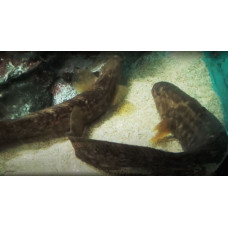Latin name
Pholidapus dybowskii
Other names
Pholidapus
Identification
Vertebrae 67-70. Body elongated and broader than in closely related species, covered with fine smooth scales, head bare. Mouth small, horizontal or slightly oblique. Teeth on jaws and coulter; no teeth on palate. One or two strong conical teeth on the premandibular bone behind a narrow band of teeth.
Features of fish fins
The posterior rays of the dorsal fin are thicker and slightly lower than the others. The pectoral fin is longer than the caudal fin. The anal fin is lower than the dorsal fin. Dorsal spines (total): 60 - 65; Dorsal soft rays (total): 0; Anal spines: 2; Anal soft rays: 38 - 41.
Fish colouring
Body coloration varies from olive to gray-brown. There are no large spots on the dorsal fin, and if there are, there are no more than four. The sides of the body are marbled.
Distribution
Northwest Pacific Ocean: from the Sea of Okhotsk to Hokkaido, the Kuril Islands and the northern part of the Sea of Japan.
Habitat
A marine bottom dwelling species. Depth range from 0 to 146 meters. Prefers temperate climates. Occurs everywhere near the bottom in the Far Eastern seas.
Size
Body length up to 45 cm.
Behavior
Most often found in seaweed thickets near the shore.
Food and feeding habits
They feed on small bottom invertebrates, mainly crustaceans.
Reproduction
In the Sea of Japan it becomes sexually mature at a length of 18-20 cm. Spawning in the Sea of Japan begins in November-December.
Fishing
It is of no commercial interest, although the flesh is quite edible.
Relationship with a person
A species harmless to humans.
| Classification | |
| Phylum | Chordata |
| Class | Actinopterygii |
| Squad | Scorpaeniformes |
| Family | Stichaeidae |
| Genus | Pholidapus |
| Species | P. dybowskii |
| Features | |
| Conservation status | No information |
| Habitat | Bottom |
| Life span, years | No information |
| Maximum body weight, kg | No information |
| Maximum length, cm | 45 |
| Sailing speed, m/s | No information |
| Threat to people | Edible |
| Way of eating | Bentophage |
Pholidapus dybowskii
Tags: pholidapus dybowskii

